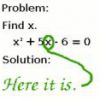 30
304. If the two adjacent sides of two rectangles are represented by the vectors \vec{p}=5\vec{a}-3\vec{b}; \vec{q}=-\vec{a}-2\vec{b} and \vec{r}=-4\vec{a}-\vec{b}; \vec{s}=-\vec{a}+\vec{b} respectively, then the angle between the vectors \vec{x}=\frac{1}{3}\left( \vec{p}+\vec{r}+\vec{s}\right) and \vec{y}=\frac{1}{5}\left( \vec{r}+\vec{s}\right) is
(a) -\cos^{-1} \left(\frac{19}{5\sqrt{43}} \right) (b) \cos^{-1} \left(\frac{19}{5\sqrt{43}} \right) (c) \pi -\cos^{-1} \left(\frac{19}{5\sqrt{43}} \right) (d) cannot be evaluated.
________________________________________________________________________________________
My attempt:
I get two equations,
6b^2-5a^2=7ab\cos \theta \dots (1)
4a^2-b^2=3ab\cos \theta \dots (2)
From this I get,
25b^2=43a^2
\Rightarrow a=\pm \frac{5b}{\sqrt{43}}
Now, how do I get rid of one value because the question is single-correct and hence only one option is right. Ans: (b)
 1708
1708\hspace{-16}$(4)::\;\;Here $\vec{p}.\vec{q}=0\Leftrightarrow \left(5\vec{a}-3\vec{b}\right).\left(-\vec{a}-2\vec{b}\right)=0$\\\\ So We Get $6\vec{b^2}-5\vec{a^2}-7\vec{a}.\vec{b}=0...............(1)$\\\\ Similarly $\vec{r}.\vec{s}=0\Leftrightarrow \left(-4\vec{a}-\vec{b}\right).\left(-\vec{a}+\vec{b}\right)=0$\\\\ So We Get $4\vec{a^2}-\vec{b^2}-3\vec{a}.\vec{b}=0.................(2)$\\\\ Now,\;\;$\vec{x}=\frac{1}{3}.\left(\vec{p}+\vec{r}+\vec{s}\right)=-\vec{b}$\\\\ Similarly $\vec{y}=\left(\vec{r}+\vec{s}\right)=-\vec{a}$\\\\ Now Angle b/w $\vec{x}$ and $\vec{y}$ is \\\\ $\cos \theta = \frac{\vec{x}.\vec{y}}{\mid \vec{x}\mid\;\mid \vec{y}\mid }=\frac{\vec{a}.\vec{b}}{\mid \vec{a}\mid\;\mid \vec{b}\mid }.......................(3)$\\\\ So From eq.$..(1)$ and $..(2)\;,$ We Get\\\\ $\mid \vec{a}\mid = \sqrt{\frac{25}{19}\left(\vec{a}.\vec{b}\right)}$ and $\mid \vec{b}\mid = \sqrt{\frac{43}{19}\left(\vec{a}.\vec{b}\right)}$\\\\
\hspace{-16}$So $\mid \vec{a}\mid\; \mid \vec{b}\mid =\frac{\sqrt{25\times 43}\left(\vec{a}.\vec{b}\right)}{19}$\\\\\\ So $\frac{\vec{a}.\vec{b}}{\mid \vec{a}\mid\;\mid \vec{b}\mid }=\frac{19}{5\sqrt{43}}$\\\\\\ So $\boxed{\boxed{\theta = \cos^{-1}\left(\frac{19}{5\sqrt{43}}\right)}}$